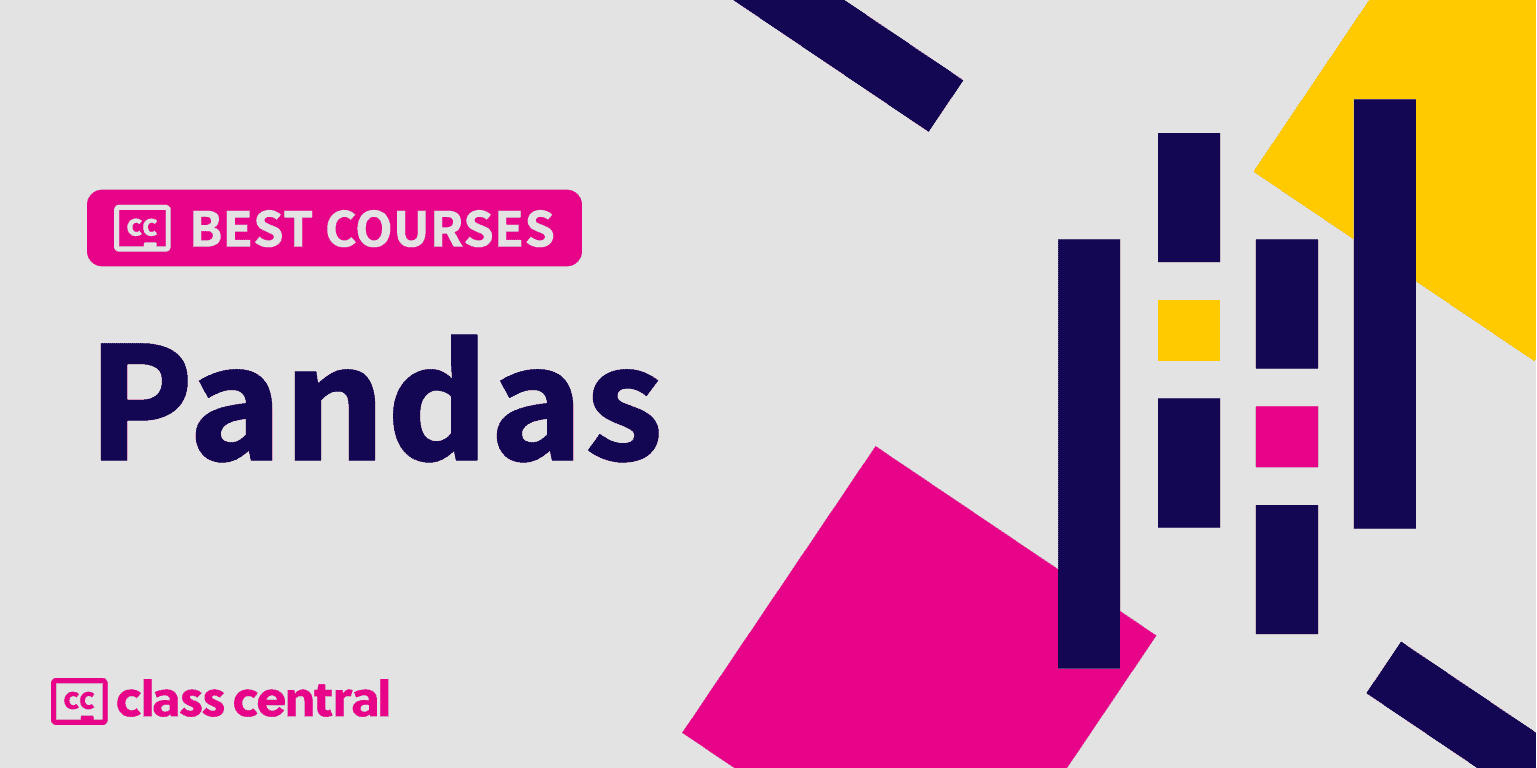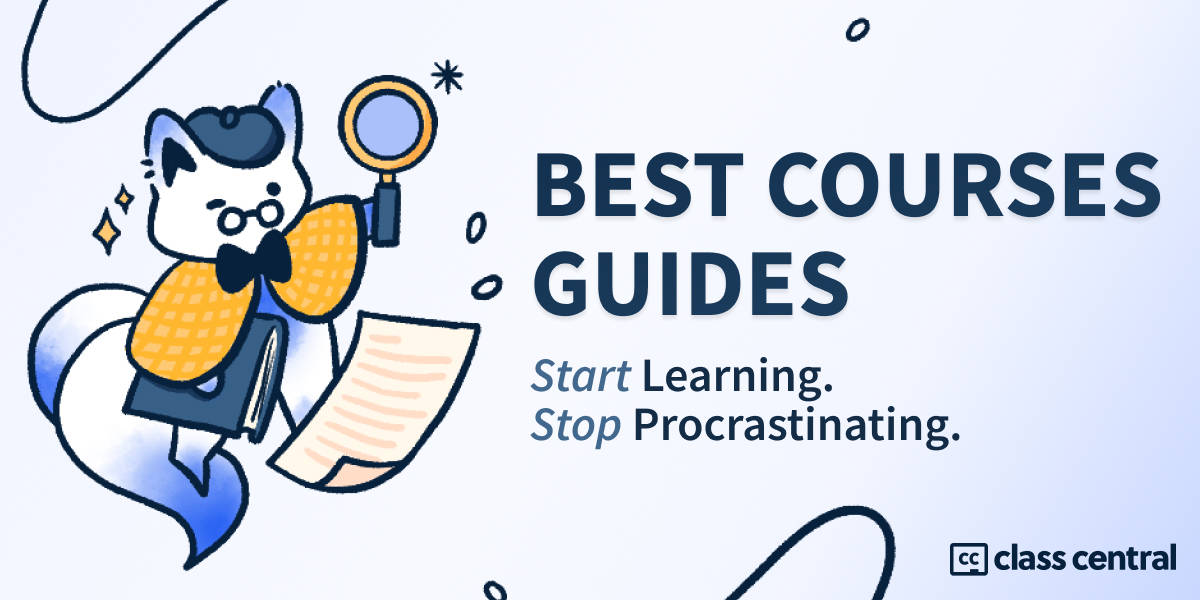10 Best Pandas Courses for 2025
Unlock the power of data analysis with the top pandas courses. Pandas is a powerful, open-source Python library.

Pandas is a powerful, open-source Python library designed for data manipulation and analysis, enabling you to seamlessly clean, transform, and visualize data with just a few lines of code.
It is the most important data science library after NumPy, with more than half of Python developers using it for data science tasks.
With Pandas, you can easily read, write, and manipulate data in various formats such as CSV, Excel, SQL databases, and more. You can also perform various operations such as filtering, grouping, merging, and reshaping data with ease. It’s a must-have tool for any data scientist or analyst!
In this Best Courses Guides (BCG), we’ve gathered top-notch pandas courses for all levels of Python programmers — from beginners just starting out to advanced programmers with experience to show —to teach you how to handle data like a pro.
Click on the shortcuts for more details:
Here are our top picks
Click to skip to the course details:
| Course Highlight | Workload |
| Best Python and pandas Course for Beginners in Data Engineering (Duke University) | 51 hours |
| Best Free Video Course for Python Programmers with Hands-On Exercises (GormAnalysis) | 2–3 hours |
| Best Free Text-Based Course for Python Programmers (Kaggle) | 4 hours |
| Best pandas Course with Interactive Exercises (DataCamp) | 4 hours |
| Best Course for Advanced pandas Users with Hands-On Exercises (LinkedIn Learning) | 1 hour |
| Best Free Course for Preparing for Data Science Job Interviews (Keith Galli) | 1–2 hours |
| Best Free Jupyter Notebook-Based Course for Python Programmers (Stefanie Molin) | N/A |
| Best Free Jupyter Notebook-Based Concise Course for Python Programmers (Julia Evans) | N/A |
| Best Free Comprehensive Course in Spanish (Tecnológico de Monterrey) | 25 hours |
| Best Free Text-Based Course in Chinese (Yuanhao Geng) | N/A |
What is pandas?
Pandas is an open-source Python library for handling and manipulating huge, complex real-world datasets. Contrary to what you may have believed, pandas is not named after the animal but a much more boring term, panel data (don’t ask me where the letter S in pandas comes from). It’s like the Swiss Army knife for data science — it has a lot of ready-made tools (from data preprocessing to analysis), it’s very versatile (you can make your own functions), and it’s a must-have for anyone working with structured data (really!).
Originally designed out of need for intensive quantitative analysis on financial data, pandas has since expanded in scope and excels in handling mixed data types, missing values, and data alignment thanks to two handy data structures:
- DataFrame: basically a very fancy spreadsheet, being two-dimensional, one-data-type-only data structure in table form with rows and columns
- Series: the opposite of a table — it is a one-dimensional array-like structure or list that can hold any data type and serves as the building block for DataFrames.
These data structures combined form a formidable team.
With half of Python developers using pandas for data science (according to the 2023 State of Python survey), pandas has established itself as one of the most widely used Python libraries for data manipulation and analysis. As a result, Pandas has become a key component in the Python data science ecosystem, alongside other prominent libraries such as SciPy, NumPy, TensorFlow, scikit-learn, and Matplotlib.
Additionally, pandas offers a plethora of built-in functions for data cleaning, aggregation, transformation, filtering, and time series analysis, making it an indispensable tool for data scientists and analysts alike.
Courses Overview
- Only one course is suitable for complete beginners, two are for intermediates, one for advanced, and the rest for beginners
- All of the courses except for two are free or free-to-audit
- Most of the courses are video-based
- Two of the courses are produced by universities, two by institutions, and the rest by independents.
Best Python and pandas Course for Beginners in Data Engineering (Duke University)
Do you have no experience with Python (or even programming for that matter) whatsoever? Then this free-to-audit course is for you! Python and Pandas for Data Engineering will teach you the Python & pandas programming skills, and also the other tools needed to manage code and build scalable projects as a data or machine learning engineer. And with lots of exercises and labs prepared to help you practice what you’ve learned, it is easy to see why this course is my first recommendation!
This course is valuable for beginners in programming who want to transform and manipulate data as a data engineer. If you enjoy this course, you should take the next courses in the Python, Bash and SQL Essentials for Data Engineering specialization, where you’ll learn Bash scripting, SQL, web scraping, web development, and more.
What you’ll learn:
- Basics of Python programming: statements and data structures like sequences, dictionaries, and generators
- Data manipulation with pandas DataFrames – an Excel-like data structure: loading, filtering, and applying functions
- Overview of alternative data manipulation: comparing pandas to NumPy and Dask
- Introduction to development environments and version control: Streaming code editing with Vim, Coding with Visual Studio Code, and version control with Git.
If you’re a verified learner, you’ll have access to the labs. These labs put you in a hands-on learning environment where you’ll complete the projects tasked. You’ll need to pass all graded assignments to complete the course and get the certificate.
| Institution | Duke University |
| Provider | Coursera |
| Part of | Python, Bash and SQL Essentials for Data Engineering Specialization |
| Instructor | Kennedy Behrman, Alfredo Deza, and Noah Gift |
| Level | Beginner |
| Workload | 51 hours |
| Enrollments | 20K |
| Rating | 4.6 / 5.0 (192) |
| Exercises | Practice quizzes (free) and labs (paid) |
| Certificate | Yes, paid |
Best Free Video Course for Python Programmers with Hands-On Exercises (GormAnalysis)
Python Pandas For Your Grandpa is a free course that covers the important aspects of pandas like reading and writing data to a file, creating data, merging data, grouping data, and so on. You’ll learn through animations and practical problems and examples to help you learn intuitively.
To take this course, you should have a basic understanding of Python (data types, lists, sets, and lambda functions) and optionally, NumPy. This course was developed with Pandas version 1.2.0 and it is the successor to Python NumPy For Your Grandma
In this course, you’ll learn:
- Overview of pandas library: purpose and benefits in data manipulation and analysis
- Series: fundamental one-dimensional data structure, operations like vectorizing, filtering, applying functions, and handling missing values
- DataFrame: two-dimensional tabular structure, operations including merging, summarizing, and grouping data
- Advanced data types and structures: handling strings, dates, times, and categorical data, using multiindex, and transforming DataFrames with pivoting and stacking.
| Channel | GormAnalysis |
| Provider | YouTube |
| Instructor | Ben Gorman |
| Level | Beginners |
| Workload | 2–3 hours |
| Views | 16K |
| Exercises | 20 in-video challenges and Google Collab exercises |
| Certificate | None |
Best Free Text-based Course for Python Programmers (Kaggle)
Kaggle is an online platform for data science competitions and collaboration, and what better way to learn pandas than from a data science website?
In this free micro-course with free certificate, you’ll learn how to manipulate data and extract insights with pandas through Jupyter notebook tutorials and hands-on challenges. These exercises will have you struggle against the quirkiness of real-world data to develop your data-wrangling skills.
No experience with pandas is required to take Kaggle’s pandas course.
You’ll learn:
- Creating and structuring data with DataFrames and Series, including reading external data like CSV files
- Selecting and modifying specific values using indexes or labels
- Using built-in aggregate functions and creating custom ones to extract insights from data
- Cleaning messy data: fixing incorrect data types, and handling missing or malformed data
- Renaming columns and combining data from multiple DataFrames or Series for coherent data packaging.
Once you finish all tutorials and exercises, you’ll earn a certificate of completion that you can show off to employers!
There’s also an active discussion board for the course that learners can use to share and discuss ideas.
| Institution | Kaggle |
| Instructor | Aleksey Bilogur |
| Level | Beginners |
| Workload | 4 hours |
| Exercises | Hands-on challenges |
| Certificate | Free |
Best pandas Course with Interactive Exercises (DataCamp)
DataCamp’s Data Manipulation with pandas course will partner you up with pandas and embark on a journey to wrangle some real-world datasets!
In this paid course with free trial, you’ll learn how to import and clean data, calculate statistics, and create visualizations with pandas through lecture videos and interactive quizzes and exercises. By the end of this course, you’ll be able to use DataFrames to effectively manipulate, analyze, and visualize all sorts of data.
You should have an intermediate level understanding of Python before taking this course.
If you have a valid university email and have signed up for the GitHub student pack, you can get a 3 months free trial from DataCamp.
| Institution | DataCamp |
| Instructors | Maggie Matsui and Richie Cotton |
| Level | Intermediate |
| Workload | 4 hours |
| Enrollments | 374K |
| Rating | 4.5 / 5.0 (237) |
| Exercises | 56 interactive exercises and MCQ |
| Certificate | Paid |
Best Course for Advanced pandas Users with Hands-On Exercises (LinkedIn Learning)
Perhaps you’re familiar with the basics of pandas, but would like to take your skills to the next level. In that case, Advanced Pandas by Brett Vanderlock is the best course for you.
This paid concise but jam-packed course with free trial will help you get the most out of your data. You’ll learn how to take advantage of some of the most advanced and critical functions pandas has to offer. From working with dates, to dealing with missing data, to transforming data frames, and to techniques for rapid exploratory data analysis, this course covers it all in its Jupyter Notebook exercises. Additionally, you’ll see what lies beyond pandas and see how Dask and Spark are used for geospatial and big data processing.
To take this course, you’ll need some basic experience with using pandas.
| Institution | Madecraft |
| Provider | LinkedIn Learning |
| Part of | Master Python for Data Science Learning Path |
| Instructors | Brett Vanderblock |
| Level | Advanced |
| Workload | 1 hour |
| Enrollments | 31K |
| Rating | 4.7 / 5.0 (546) |
| Certificate | Paid |
Best Free Course for Preparing for Data Science Job Interviews (Keith Galli)
If you’re learning pandas in the hopes of pursuing a career in data science, then you’ll also need to prepare for the pesky interview questions a company might throw at you. This is where Keith Galli’s course, Solving Real-World Data Science Interview Questions!, comes in.
Keith spent many years interviewing and hiring candidates for data science positions, and he’ll teach you in this free course many of the things an interviewer looks for in a successful candidate. You’ll solve interview questions from easy to hard.
You should have some experience with pandas to take this course.
This course is divided into two parts. The first part focuses on coding with pandas where you’ll solve classic interview questions:
- Find the current salary of each employee in a dataset with old and outdated information
- Find the average number of bathrooms and bedrooms for each city’s property type in a dataset
- Find the number of occurrences of the words ‘bull’ and ‘bear’ in a text
- Calculate the customer revenue of a company’s dataset in March
- Given a table of purchases by date, calculate the monthly percentage change in revenue
- Find the total number of downloads for premium vs freemium in a dataset.
The second part does not involve any coding at all, unlike the first part, and will instead challenge your critical thinking and problem-solving abilities. You’ll come up with innovative, high-level solutions to different data science problems:
- How can you find where a person lives based on their credit card activity?
- What methods can you use to detect outliers in a dataset?
- What is the probability that a girl has a sister from a probability distribution?
- Uber Black rides have dropped by 10%. How would you investigate this reduction?
- And finally, how would you approach the task of processing a Terabyte of data using a Python script?
| Channel | Keith Galli |
| Provider | YouTube |
| Instructor | Keith Galli |
| Level | Intermediate |
| Workload | 1–2 hours long |
| Views | 108K |
| Likes | 3.2K |
| Certificate | None |
Best Free Jupyter Notebook-Based Course for Python Programmers (Stefanie Molin)
Looking to learn through hands-on experience with Jupyter notebooks and exercises as you go? If so, Stefanie Molin’s Pandas Workshop is the perfect fit for you! This course has been delivered at five different conferences and is completely free.
Throughout the workshop, you will develop the essential pandas skills needed to manipulate and analyze data. This includes filtering, aggregating, reshaping, and more. In addition, you’ll learn how to effectively visualize your data using popular plotting libraries like matplotlib and seaborn.
Before taking this course, it’s recommended that you have a basic understanding of Python and feel comfortable using Jupyter Notebooks.
What you’ll learn:
- Fundamentals of pandas: working with Series, DataFrame, and Index classes
- Data wrangling: cleaning and formatting data, renaming columns, handling data type inconsistencies, and reshaping data
- Data visualization: plotting data using Matplotlib and Seaborn, creating histograms, line plots, and more
- Practical application: analyzing 2019 US flight data in a comprehensive lab session.
This course is made up of 4 sections, in Jupyter notebook form and slide form. You’ll learn by running the cells and experimenting with them. Each section contains exercises, which you should complete in the workbook.ipynb notebook. The solutions to the exercises as well as the lab are given in the course.
Additional info:
- Stefanie Molin is a software engineer and data scientist at Bloomberg in New York City. She specializes in tackling complex issues in information security, with a focus on data wrangling/visualization, developing data-gathering tools, and promoting knowledge sharing.
- She is also the author of Hands-On Data Analysis with Pandas, a Python data science handbook for data collection, wrangling, analysis, and visualization.
| Provider | GitHub |
| Author | Stefanie Molin |
| Level | Beginner |
| Workload | N/A |
| Forks | 636 |
| Stars | 318 |
| Certificate | None |
Best Free Jupyter Notebook-Based Concise Course for Python Programmers (Julia Evans)
The 80:20 rule also applies to pandas: 80% of the results comes from 20% of the effort.
So what 20% of pandas do you need to learn to get 80% of the results?
The common code patterns and programming recipes used in pandas of course!
In Julia Evan’s free open source course, Pandas cookbook, you’ll quickly get started with pandas. How? This short yet info-packed course cleans, explores, and analyzes three real-world datasets in Jupyter notebooks, putting you in the shoes of a data scientist. You’ll learn how to tackle the common problems real-world datasets normally arrive with.
This course is made up of 9 chapters, whose topics are:
- Introduction to Jupyter Notebook, including tab completion and magic functions
- Reading data from a CSV file into pandas
- Selecting and manipulating data in pandas dataframes, including filtering and slicing
- Using groupby and aggregate functions to analyze data
- Combining dataframes and web scraping with pandas
- Working with strings in pandas dataframes, including vectorized string operations
- Cleaning up messy data using pandas
- Parsing Unix timestamps
- Loading data from SQL databases (SQLite3, PostgreSQL, and MySQL) into pandas with examples.
You’ll learn by reading through the course chapters and taking note of the tips and problems presented in the course. You’ll also be able to run and test the code in the Jupyter Notebook.
Additional info:
- Julia Evans is a software developer at her own programming zines business, wizard zines.
- You can run this course by git-cloning it to your PC, or if you’re lazy (like me), you can run it online.
- This repo has also been translated to Chinese.
| Provider | GitHub |
| Instructor | Julia Evans |
| Level | Beginner |
| Workload | N/A |
| Forks (Enrollments) | 2.1K |
| Stars | 6.1K |
| Certificate | None |
Best Free Comprehensive Course in Spanish (Tecnológico de Monterrey)
If you speak Spanish, I have the perfect course for you from Tecnológico de Monterrey in Mexico.
Analíticas de Datos con Pandas will have you embark on an exciting journey through the world of data analytics with pandas. Through this free-to-audit course, you’ll learn the concepts, methods, and functions of pandas (and some matplotlib), allowing you to rapidly and easily analyze data by creating and manipulating DataFrames.
No prior experience with pandas is required to take this course.
This course is structured into four sections:
- First Steps with Pandas: Installation and setup, fundamental elements, and the history and popularity of pandas
- Main Components in Pandas: Data manipulation with Series and DataFrames, and essential pandas functions
- Operations in Pandas: Basic and advanced operations for calculations on data structures, columns, rows, and string data
- Use Cases with Pandas: Exploratory Data Analysis (EDA) and data visualization techniques with matplotlib.
| Institution | Tecnológico de Monterrey |
| Provider | Coursera |
| Instructor | Jesus Aguilar Gonzalez |
| Level | Beginner |
| Workload | 25 hours |
| Exercises | Practice quizzes, discussion questions, graded quizzes, and peer-reviewed assignments |
| Certificate | Paid |
Best Free Text-Based Course in Chinese (Yuanhao Geng)
Joyful Pandas is probably the best free pandas tutorial written in Simplified Chinese.
This course covers all the core operations and features of pandas (and even some native Python concepts and some NumPy basics) you need to get started with data analysis! It is divided into three modules: basic knowledge, four types of operations, and four types of data.
The PDF version, notebook version, and datasets of this tutorial can be downloaded from the github. Meanwhile, you can find the online version of this tutorial here.
Yuanhao Geng, a member of Datawhale and active contributor to the pandas ecosystem, holds a master’s degree in statistics from the University of Wisconsin-Madison. He is also the author of “pandas数据处理与分析,” a printed version of this tutorial that includes additional chapters on data visualization, feature engineering, and performance optimization.
In this course, you’ll learn:
- Basic Knowledge: Recap of Python’s native capabilities like list comprehensions and anonymous functions, and an introduction to NumPy and its array operations
- Four Types of Operations: Indexing, grouping, reshaping, and merging DataFrames
- Four Types of Data: Handling text data, categorical data, time series data, and managing missing data with techniques like summarization, deletion, filling, and interpolation
This course has also been selected by the official pandas team as a recommended community tutorial.
| Institution | Datawhale |
| Instructor | Yuanhao Geng |
| Level | Beginner |
| Forks | 1.8K |
| Stars | 4.4K |
| Exercises | 80 practice questions and 20 exercises |
| Certificate | None |
Why You Should Trust Us
Class Central, a Tripadvisor for online education, has helped 60 million learners find their next course. We’ve been combing through online education for more than a decade to aggregate a catalog of 200,000 online courses and 200,000 reviews written by our users. And we’re online learners ourselves: combined, the Class Central team has completed over 400 online courses, including online degrees.
Best Courses Guides Methodology
I built this ranking following the now tried-and-tested methodology used in previous Best Courses Guides (you can find them all here). It involves a three-step process:
- Research: I started by leveraging Class Central’s database. Then, I made a preliminary selection of 600+ panda courses by rating, reviews, and bookmarks.
- Evaluate: I read through reviews on Class Central, Reddit, and course providers to understand what other learners thought about each course and combined it with my own experience as a learner.
- Select: Well-made courses were picked if they presented valuable and engaging content. They have to fit in a set of criteria including comprehensive curriculum, affordability, release date, ratings and enrollments.
Fabio revised the research and the latest version of this article.

Elham Nazif



















